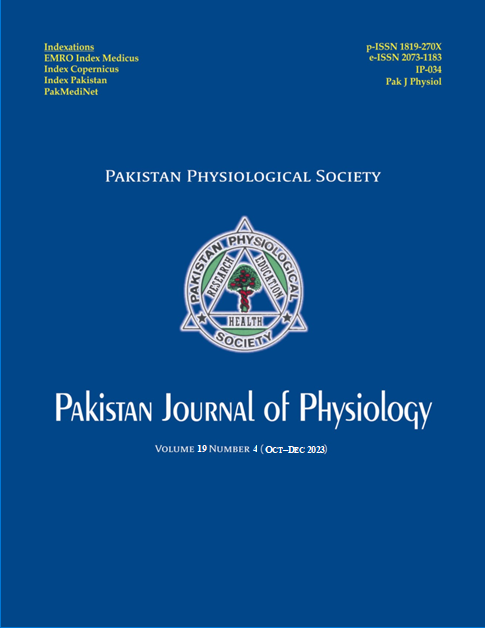CYTOLOGICAL AND BIOCHEMICAL IMPACT OF ARSENIC EXPOSURE ON THE ENDOCRINE SYSTEM AND OESTROUS CYCLE OF FEMALE RATS
DOI:
https://doi.org/10.69656/pjp.v19i4.1606Keywords:
female rats, Arsenic, Estradiol, Oestrus cycle, ProgesteroneAbstract
Background: Rising concentration of arsenic in drinking water is severely damaging the reproductive health of both humans and animals. This study was thus designed to evaluate the deleterious effects of sodium arsenite at a minimum dose on the endocrine system and oestrus cycle of female Sprague Dawley rats. Methods: A randomized control trial was conducted at College of Physicians & Surgeons Pakistan, Regional Centre, Islamabad. Sixty healthy female Sprague Dawley rats were randomly divided into group 1 (control) and group 2 (experimental) with 30 rats in each group. After one week of acclimatization, the control group was administered 10 ml of distilled water daily via oral gavage, and the experimental group was administered 4 µg of sodium arsenite dissolved in 10 ml of distilled water daily via oral gavage. After one week of habituation, vaginal smears were taken daily to study the oestrus cycle. Whereas, serum oestrogen and progesterone levels were assessed using ELISA after 14 days of intervention. Biochemical parameters (oestrogen and progesterone) were analyzed on SPSS-22. Comparison of means of these hormones was evaluated by the Student’s t-test. Results: After exposure to sodium arsenite, the oestrus cycle of the experimental group was prolonged and halted in the diestrus phase along with significant reduction of serum estradiol and progesterone levels. Conclusion: Low dose of arsenic delays and disturbs regulation of oestrus cycle and disrupts the hormonal levels in female rats. Pak J Physiol 2023;19(4):19–22Downloads
References
Palma-Lara I, Martínez-Castillo M, Quintana-Pérez J, Arellano-Mendoza M, Tamay-Cach F, Valenzuela-Limón O, et al. Arsenic exposure: A public health problem leading to several cancers. Regulatory Toxicol Pharmacol 2020;110:104539. DOI: 10.1016/j.yrtph.2019.104539.
Ahmad A, Bhattacharya P. Arsenic in drinking water: Is 10 ?g/L a safe limit? Current Pollution Reports 2019;5:1–3. DOI: 10.1007/s40726-019-0102-7.
Thakur BK, Gupta V, Bhattacharya P, Jakariya M, Islam MT. Arsenic in drinking water sources in the Middle Gangetic Plains in Bihar: An assessment of the depth of wells to ensure safe water supply. Groundwater for Sustainable Development 2021;12:100504. DOI: 10.1016/j.gsd.2020.100504.
Shah AH, Shahid M, Khalid S, Natasha, Shabbir Z, Bakhat HF, et al. Assessment of arsenic exposure by drinking well water and associated carcinogenic risk in peri-urban areas of Vehari, Pakistan. Envir Geochem Health 2020;42:121–33. DOI: 10.1007/s10653-019-00306-6.
Ur Rehman H, Ahmed S, Ur Rahman M, Mehmood MS. Arsenic contamination, induced symptoms, and health risk assessment in groundwater of Lahore, Pakistan. Envir Sci Pollution Res 2022;29(33):49796–807.
Fatoki JO, Badmus JA. Arsenic as an environmental and human health antagonist: A review of its toxicity and disease initiation. J Hazardous Materials Advances 2022;5:100052. DOI: 10.1016/j.hazadv.2022.100052
Adeniyi M, Agoreyo F. Estrous cycle ratio as a reproductive index in the rats. Am J Biomed Sci Res 2019;4(2):100-3. DOI: 10.34297/ajbsr.2019.04.000772
Sabir S, Akash MSH, Fiayyaz F, Saleem U, Mehmood MH, Rehman K. Role of cadmium and arsenic as endocrine disruptors in the metabolism of carbohydrates: Inserting the association into perspectives. Biomed Pharmacother 2019;114:108802. DOI: 10.1016/j.biopha.2019.108802.
Ommati MM, Shi X, Li H, Zamiri MJ, Farshad O, Jamshidzadeh A, et al. The mechanisms of arsenicinduced ovotoxicity, ultrastructural alterations, and autophagic related paths: An enduring developmental study in folliculogenesis of mice. Ecotoxicol Environ Safety 2020;204:110973. DOI: 10.1016/j.ecoenv.2020.110973.
Fan Y, Jiang X, Xiao Y, Li H, Chen J, Bai W. Natural antioxidants mitigate heavy metal induced reproductive toxicity: prospective mechanisms and biomarkers. Crit Rev Food Sci Nut 2023:1–13.
Massányi P, Massányi M, Madeddu R, Stawarz R, Luká? N. Effects of cadmium, lead, and mercury on the structure and function of reproductive organs. Toxics 2020;8(4):94.
Pantier LK, Li J, Christian CA. Estrous cycle monitoring in mice with rapid data visualization and analysis. Bio-protocol 2019;9(17):e3354-e.
Sano K, Matsuda S, Tohyama S, Komura D, Shimizu E, Sutoh C. Deep learning-based classification of the mouse estrous cycle stages. Scientific Reports 2020;10(1):11714.
Abdel-Mottaleb Y, Ali HS, El-Kherbetawy MK, Elkazzaz AY, ElSayed MH, Elshormilisy A, et al. Saponin-rich extract of Tribulus terrestris alleviates systemic inflammation and insulin resistance in dietary obese female rats: Impact on adipokine/hormonal disturbances. Biomed Pharmacother 2022;147:112639. DOI: 10.1016/j.biopha.2022.112639.
Bjørklund G, Oliinyk P, Lysiuk R, Rahaman MS, Antonyak H, Lozynska I, et al. Arsenic intoxication: general aspects and chelating agents. Arch Toxicol 2020;94:1879–97. DOI: 10.1007/s00204020-02739-w.
Ajayi AF, Akhigbe RE. Staging of the estrous cycle and induction of estrus in experimental rodents: an update. Fertil Res Pract 2020;6(1):1–15.
Dávila-Esqueda ME, Jiménez-Capdeville ME, Delgado JM, De la Cruz E, Aradillas-García C, JiménezSuárez V, et al. Effects of arsenic exposure during the pre-and postnatal development on the puberty of female offspring. Exp Toxicol Pathol 2012;64(1–2):25–30. DOI: 10.1016/j.etp.2010.06.001.
Chen P, Luo Q, Lin Y, Jin J, Hu K-L, Wang F, et al. Arsenic exposure during juvenile and puberty significantly affected reproductive system development of female SD rats. Ecotoxicol Environ Safety 2022;242:113857. DOI: 10.1016/ j.ecoenv.2022.113857.
Souza ACF, Ervilha LOG, Coimbra JLP, Bastos DSS, Guimarães SEF, Machado?Neves M. Reproductive disorders in female rats after prenatal exposure to sodium arsenite. J App Toxicol 2020;40(2):214–23. DOI: 10.1002/jat.3897.
Herbison AE. A simple model of estrous cycle negative and positive feedback regulation of GnRH secretion. Frontiers Neuroendocrinol 2020;57:100837.
Biswas P, Mukhopadhyay A, Kabir SN, Mukhopadhyay PK. High-protein diet ameliorates arsenicinduced oxidative stress and antagonizes uterine apoptosis in rats. Biological Trace Element Research. 2019;192:222–33. DOI: 10.1007/s12011-019-1657-2.
Downloads
Published
How to Cite
Issue
Section
License

This work is licensed under a Creative Commons Attribution-NoDerivatives 4.0 International License.
The author(s) retain the copyrights and allow their publication in Pakistan Journal of Physiology, Pak J Physiol, PJP to be FREE for research and academic purposes. It can be downloaded and stored, printed, presented, projected, cited and quoted with full reference of, and acknowledgement to the author(s) and the PJP. The contents are published with an international CC-BY-ND-4.0 License.











